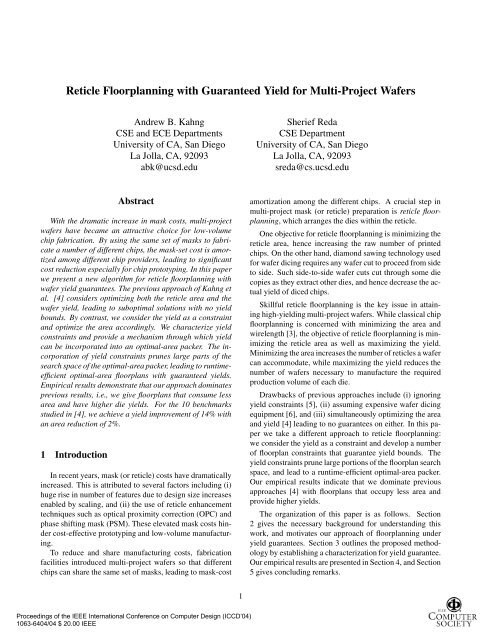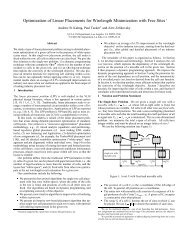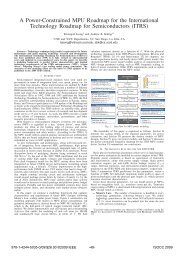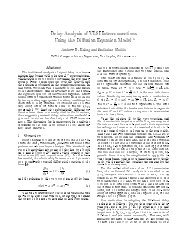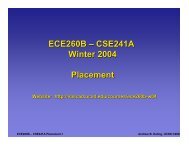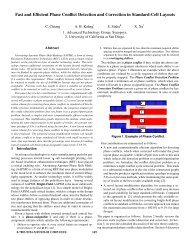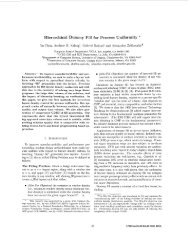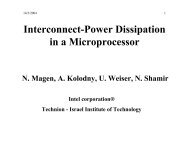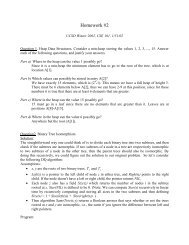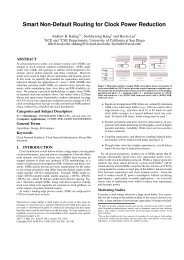Reticle floorplanning with guaranteed yield for multi-project wafers ...
Reticle floorplanning with guaranteed yield for multi-project wafers ...
Reticle floorplanning with guaranteed yield for multi-project wafers ...
Create successful ePaper yourself
Turn your PDF publications into a flip-book with our unique Google optimized e-Paper software.
<strong>multi</strong>−<strong>project</strong> reticledicing (cutting) linewaferdied 1 d2d3d7d6d4d5417582936Figure 1. <strong>Reticle</strong>/Die overview.2 Background and motivationA wafer consists of a number of reticle “shots” arrangedin m rows and n columns as shown in Figure 1; we referto these as reticle rows and by reticle columns, respectively.Each reticle can have a number of dies from differentdesigns. The side-to-side dicing model [4] assumes thatthe wafer-cutting tool cannot arbitrarily stop during cutting;consequently, all reticles in same reticle row (or reticle column)will be cut (or diced) by the same set of horizontal(or vertical) cuts. A dicing plan specifies a set of cuttinglines. These cutting lines determine which dies will be usableand which will be destroyed. For example, the cuttingline on the first reticle row in Figure 1 successfully extractsdie d 3 , but destroys dies d 1 and d 2 . Notice also that a cutline that extracts d 1 does not eliminate the need <strong>for</strong> cut lines<strong>for</strong> d 2 and d 3 , since such a cut line will leave excess margin<strong>for</strong> each of d 2 and d 3 . Given a reticle floorplan <strong>with</strong> a setof dies D = {d 1 ,d 2 ,...,d l },thewafer <strong>yield</strong> is defined asthe minimum, over all dies d k ∈ D, of the number of successfullyextracted copies of d k . The objective of a dicingplan is to maximize the <strong>yield</strong>, since this translates to fewer<strong>wafers</strong>.In the reticle <strong>floorplanning</strong> approach of Kahng et al. [4],the primary objective is minimizing the total reticle area andthe secondary objective is maximizing the <strong>yield</strong>. We noticethat minimizing the reticle area will likely lead to adverseimpacts on the <strong>yield</strong>. From Kahng et al. [4] results (duplicatedin Table 1 <strong>for</strong> convenience), we observe that there isstrong correlation between area and <strong>yield</strong>. Comparing resultsfrom Parquet - a well-established <strong>yield</strong>-oblivious areapacker - and the “shelf” packer - an area packer <strong>with</strong> <strong>yield</strong>as a secondary objective - we find that there is a strong correlationbetween the area and <strong>yield</strong> in the results of thesefloorplanners, i.e., smaller areas lead to lower <strong>yield</strong>s andlarger areas lead to higher <strong>yield</strong>s. The low <strong>yield</strong> associated<strong>with</strong> smaller areas will eventually lead to large wasteddie areas during side-to-side dicing, outweighing any initialarea savings.In this work we suggest a different approach. We con-Figure 2. <strong>Reticle</strong> floorplans as grids.struct floorplans that consider specified <strong>yield</strong> bounds as constraintsand find a packing that minimizes the reticle areawhile respecting the constraints. The main challenge <strong>with</strong>our approach is specifying and satisfying the <strong>yield</strong> constraintsat all times while constructing the reticle floorplan.To simplify the <strong>yield</strong> calculations, we restrict the floorplansto grids as shown in Figure 2 and use this as a starting point<strong>for</strong> developing a characterization <strong>for</strong> <strong>yield</strong> guarantee. Wenote that Andersson et al. [5] propose a Polynomial-TimeApproximation Scheme (PTAS) to pack dies into grids underthe sole objective of minimizing the reticle area <strong>with</strong> noregard to the <strong>yield</strong>. Our work is different: we take the <strong>yield</strong>as a constraint and develop a practical methodology <strong>for</strong> reticle<strong>floorplanning</strong>. Our approach can be summarized in threesteps: (i) restrict floorplans to grids, (ii) develop a characterization<strong>for</strong> <strong>yield</strong> of grid floorplans, and (iii) pack the diesin the grid optimally using branch and bound respecting thespecified rules <strong>for</strong> <strong>yield</strong> guarantee.3 Proposed MethodologyIn our methodology, we restrict floorplans to grids. Agrid is composed of a number q of grid rows and a numberp of grid columns as shown in Figure 2 (compare againstreticle rows and columns). A grid representation allowsthe development of a characterization <strong>for</strong> <strong>yield</strong> guaranteewhich we give in Subsection 3.2. We discuss our optimalarea packer in Subsection 3.3. We now <strong>for</strong>mulate the reticlefloorplan problem.3.1 Problem FormulationGiven a set of dies D = {d 1 ,d 2 ,...,d l },wedefinethefollowing:• w i gives the width of a given die d i ∈ D.• h i gives the height of a given die d i ∈ D.Let a variable x ijk =1if and only if die d k is placed atgrid row i andgridcolumnj; otherwise, x ijk =0.Definethe following two sets:λ j = {w k |∃i, k such that x ijk =1}, (1)Proceedings of the IEEE International Conference on Computer Design (ICCD’04)1063-6404/04 $ 20.00 IEEE
andπ i = {h k |∃j, k such that x ijk =1}. (2)λ j (π i ) gives the set of width (height) values of cells placedin grid column j (grid row i). Considering that the width(height) of a column (row) is determined by the largestwidth (height) die residing in that row (column), the objectiveof minimizing the grid area can be written asp∑q∑min max w × max h, (3)w∈λ j h∈π ij=1i=1such thatp∑ q∑∀k : x ijk =1 (4)∀i, j :j=1 i=1l∑x ijk ∈{0, 1} (5)k=1The constraint given by Equation (4) states that each diemust be placed, and the constraint given by Equation (5)states that each slot in the grid can be occupied by at mostone die.While optimizing the objective function given by Equation(3) gives an optimal grid packing, these packings offerno <strong>yield</strong> guarantees. We next develop the necessary constraints<strong>for</strong> attaining any desired <strong>yield</strong>, and <strong>for</strong> obtaining asmooth tradeoff between <strong>yield</strong> and packing area.3.2 Floorplanning <strong>with</strong> Yield GuaranteeAn independent row set is a set of dies <strong>with</strong>in a grid rowthat have the same height; π i (as given by Equation 2) givesthe number of independent row sets <strong>with</strong>in a grid row i.Similarly, an independent column set is a set of dies <strong>with</strong>ina grid column that have the same width; λ j (as given byEquation 1) gives the number of independent column sets<strong>with</strong>in a column grid j. An independent set can be diced atthe same time.For the special case of 100% <strong>yield</strong>, there must be atmost one independent row set per row and at most one independentcolumn set per column, i.e, ∀i : π i = 1 and∀j : λ j = 1. That is, if 100% <strong>yield</strong> is to be achieved,each row in a grid must accommodate dies of only the sameheight and each column in the grid must accommodate diesof only the same width. Given 100% <strong>yield</strong> as a constraint,one has to find the minimum area floorplan that satisfies this<strong>yield</strong>. To reduce the reticle area at the expense of the <strong>yield</strong>,we can allow (i) different die heights to reside in the samegrid row, and (ii) different die widths to reside in the samegrid column. Under the assumed dicing model, if a row(column) contains dies of different heights (widths) thenany dicing plan that extracts dies of the one height (width)must damage all dies of different heights (widths).Assume a wafer has m reticle rows and n reticlecolumns, <strong>with</strong> a total of m × n reticles shots. Furtherassume that we are given a reticle floorplan where somedie d k is placed at grid row i andgridcolumnj, i.e.,x ijk =1. Then, a constructive lower bound on the numberof reticle rows where copies of die d k are extracted is⌊ m|π i|⌋. Similarly, a constructive lower bound on the numberof reticle columns where copies of die d k are extracted is⌊ n|λ ⌋. Hence the number of copies c j| k extracted of died k is at least c k = ⌊ m|π ⌋×⌊ ni| |λ j|⌋. The <strong>yield</strong> is equalto min dk ∈D c k . The following example illustrates <strong>yield</strong>calculation.Example 1: Assume a wafer of m =10reticle rows andn =10reticle columns. Consider some grid row i that hasa set of dies of two different heights π i = {h 1 ,h 2 }, while<strong>for</strong> all grid columns j, |λ j | =1, i.e., no grid column accommodatesdies of different width. Furthermore, assume anumber m 1 of reticle rows will be used to extract all dies ofheight h 1 , while a number m 2 of reticle rows will be usedto extract dies of height h 2 . Since m = m 1 + m 2 maximizingthe <strong>yield</strong> implies maximizing the minimum of m 1 nand m 2 n. This occurs when m 1 = m 2 = 10 2=5,givinga<strong>yield</strong> of 50.The general relationship between <strong>yield</strong>, the number ofdifferent heights per row π i , and the number of differentwidths per column λ j is captured by the following theorem.We derive the relation between <strong>yield</strong> and area using asingle parameter γ ∈ Z + .Asγ increases, the reticle areadecreases and the <strong>yield</strong> decreases. To produce conciseexpressions, we make the reasonable assumption thatm = n.Theorem 1. Given a wafer of m rows and n columns, a<strong>yield</strong> of at least m2 −m(γ+1)γis attained if the following constraintis met: ∀d k ∈ D :[x ijk =1]→ [ |π i |×|λ j |≤γ ].Proof: Assume ∀d k ∈ D :[x ijk =1]→ [ |π i |×|λ j |≤γ ]. Hence, according to our earlier discussion: <strong>for</strong> anydie d k ,wherex ijk =1, a constructive lower bound c k onthe number of die copies of d k is c k = ⌊ m π i⌋×⌊ n λ j⌋ =n−n mod λj×λ j.Sinceπ i λ j ≤ γ,m−m mod π iπ ic k ≥ (m − m mod π i)(n − n mod λ j ). (6)γAssuming that m = n thenc k ≥ (m2 − m(m mod π i + m mod λ j )+(m mod π i × m mod λ j ).γ(7)Since m mod π i
Input: Die d to be placed. n is the total number of dies. wis the number of grid columns. h is the number of gridrows. Initialize bestcost = ∞Output: Optimal <strong>floorplanning</strong> <strong>for</strong> the specified <strong>yield</strong>1. if d ≤ n then2. <strong>for</strong> i =1to h +1do3. <strong>for</strong> j =1to w +1do4. if no dies are placed at (i, j) and placing d at (i, j)does not violate <strong>yield</strong> constraints then5. Place die d at (i, j)6. cost = evaluate area of partial floorplan7. if cost < bestcost then search(d +1, n, w +1,h +1)8. Undo placing d at (i, j)9. Flip die d and repeat steps 4 ...710. else11. cost = evaluate area of complete floorplan12. if cost < bestcost then13. bestcost = cost14. Store the current floorplan as the best floorplanFigure 3. search(): a branch and bound procedure<strong>with</strong> <strong>yield</strong> guarantee.Maintaining the constraint of Theorem 1 while reticle<strong>floorplanning</strong> ensures packings <strong>with</strong> <strong>guaranteed</strong> <strong>yield</strong>s asgiven by Equation (6). Note that Equation (8) gives a lesstight lower bound than that given by Equation (6); this wasnecessary to arrive to a concise expression. The additionof the <strong>yield</strong> constraint to the <strong>for</strong>mulation of Subsection 3.1prunes the search space <strong>for</strong> finding optimal packings under<strong>guaranteed</strong> <strong>yield</strong>s. We exploit this in the next subsection.3.3 Floorplanning Under Yield GuaranteesOur reticle floorplanner seeks to construct a grid floorplan<strong>with</strong> optimal area as given by Equation (3) while respectingthe <strong>yield</strong> rule as given by Theorem 1 and the constraintsgiven by Equations (4) and (5). For this purpose, weemploy a branch and bound procedure <strong>with</strong> lower bounds.Experimental results show that such approach is practicallyfeasible. We can attribute this to three reasons: (i) reticlefloorplan instances are small, (ii) <strong>yield</strong> constraints prunea huge amount of the search space, and (iii) using lowerbounds further prunes large portions of the search space.The complete branch and bound search() procedure isgiven in Figure 3. Given a grid of w columns and h rows,the branch and bound procedure places die sequentially.Given a current die d, the procedure places d at each gridslot (steps 2 ...3) and branches (step 7) to place the remainingdies. For a die to be legally placed in a grid slot, noneof the <strong>yield</strong> constraints should be violated (step 4). Lowerbounds are utilized (steps 6 ...7) to prune solutions that arenot promising. The procedure also expands the current gridby an extra column and row (in loop bounds of steps 2 and3), and evaluates placements in the additional slots. Thisexpansion is required since it is possible that none of currentgrid slots is legal. For each die, we also consider flipping,i.e., rotating the die by 90 degrees as given in Step9. If all dies are placed then grid area is evaluated and comparedto the best grid floorplan area constructed so far (steps11 ...14).4 Experimental ResultsWe evaluate our technique using the benchmarks suppliedby authors of [4]. We also utilize the dicing-plancode of [4] as an independent means to evaluate the <strong>yield</strong>of our reticle floorplans. We assume (as [4]) a wafer thatcan accommodate m =10reticle rows and n =10reticlecolumns. This means that the wafer has 100 reticle shots.All of our experiments are run using a Linux Intel Xeon2.4GHz workstation <strong>with</strong> 2GB memory.For convenience, we duplicate all the results of [4] in Table1. #Die gives the number of dies in each test case, andDie area gives the total die area. GTMuch [2] is a commercialreticle floorplanner. Parquet [1] is a <strong>yield</strong>-obliviousmin-area floorplanner. Shelf+Shift and SA+IASA are thetwo approaches proposed by [4]. For each floorplanner, wereport the <strong>yield</strong>, reticle area, and the CPU runtime. All ofthese approaches allow die flipping.Table 2 gives the results from our method. We givea spectrum of results <strong>for</strong> <strong>yield</strong>s corresponding to γ =1, 2, 3, 4, and 5. We observe that our approach allows agraceful tradeoff between the reticle area and <strong>yield</strong>. Theright most column of Table 2 “Matched Yield” gives resultswhen we use the best <strong>yield</strong> values of [4] in Table 1 as alower bound on the <strong>yield</strong> <strong>for</strong> our floorplanner, and calculatethe area using our approach. Our approach outper<strong>for</strong>msprevious method in the following respects:• We af<strong>for</strong>d the ability to control the <strong>yield</strong>, in contrast toprevious approaches which offer no guarantees aboutthe <strong>yield</strong>. Furthermore, our results offer a gracefultradeoff between <strong>yield</strong> and area.• Our matched <strong>yield</strong> approach dominates the SA+IASAtechnique of [4] <strong>for</strong> all but one benchmark, i.e., we givereticle floorplans that are better in both <strong>yield</strong> and area.For the 10 reticle floorplans studied in [4], we achievea simultaneous <strong>yield</strong> improvement of 14% and an areareduction of 2%.The results of Table 2 are summarized in the plot of Figure4, where we plot all Pareto points corresponding to theProceedings of the IEEE International Conference on Computer Design (ICCD’04)1063-6404/04 $ 20.00 IEEE
Case No.#Die Die area GTmuch Parquet Shelf+shift SA+IASA<strong>yield</strong> area <strong>yield</strong> area CPU(s) <strong>yield</strong> area CPU(s) <strong>yield</strong> area CPU(s)1 10 231 18 255 14 255 0.03 16 276 0.00 28 288 802 18 226 16 285 5 252 0.07 21 253 0.16 25 270 7833 11 252 15 280 10 272 0.03 16 280 0.01 30 294 1324 9 203 18 221 14 220 0.03 25 224 0.01 30 288 1185 10 226 12 272 15 247 0.02 25 280 0.00 25 260 946 15 227 10 285 6 252 0.06 18 238 0.00 18 238 2267 15 234 14 285 9 252 0.06 15 288 0.01 20 285 7828 14 232 20 285 9 255 0.03 20 288 0.00 20 288 1529 10 231 20 285 14 255 0.03 16 276 0.00 28 288 16110 20 215 6 304 6 238 0.09 15 255 0.01 20 260 1020Total 2277 149 2757 102 2518 187 2668 244 2757Table 1. Results of [4]. Yield is the minimum percentage of die copies diced from the wafer under therespective dicing plan.#Die Die γ =1 γ =2 γ =3 γ =4 γ =5 Matched YieldCasearea <strong>yield</strong> area CPU(s) <strong>yield</strong> area CPU(s) <strong>yield</strong> area CPU(s) <strong>yield</strong> area CPU(s) <strong>yield</strong> area CPU(s) <strong>yield</strong> area CPU(s)1 10 231 100 494 0.02 50 312 0.03 30 288 0.02 25 270 0.07 20 264 0.01 30 288 0.022 18 226 100 396 25.23 50 286 227.02 30 275 344.09 28 260 4705.30 20 275 417.11 28 260 4705.303 11 252 100 456 0.04 50 312 0.04 30 300 0.03 30 290 0.15 20 288 0.01 30 290 0.154 9 203 100 500 0.01 50 300 0.03 30 264 0.01 25 252 0.14 20 256 0.02 30 264 0.015 10 226 100 560 0.03 50 336 0.05 30 285 0.09 25 260 0.33 20 280 0.04 25 260 0.036 15 227 100 494 8.61 50 306 10.22 30 275 6.46 25 276 93.55 30 275 6.41 30 275 6.417 15 234 100 416 0.41 50 297 4.03 30 280 4.00 25 270 49.78 30 280 1.46 25 270 49.788 14 232 100 416 0.41 50 297 2.58 30 280 3.66 25 270 48.58 20 273 1.55 25 270 48.589 10 231 100 494 0.02 50 312 0.03 30 288 0.02 25 270 0.07 20 264 0.01 30 288 0.0210 20 215 100 360 36.74 50 270 290.32 30 240 306.33 25 270 6446.10 30 240 278.07 30 240 278.07Total 2277 1000 4586 - 500 3028 - 300 2775 258 2688 230 2443 - 283 2705 -Table 2. Results of the proposed technique. Yield is the minimum percentage of die copies dicedfrom the wafer under the respective dicing plan. γ is an upper bound on π i × λ j <strong>for</strong> all rows i andcolumns j as defined in the text.(<strong>yield</strong>, area) tradeoff. The results establish a Pareto frontier,allowing a graceful tradeoff between area and <strong>yield</strong>.5 Discussions and ConclusionsIn this paper we have presented a new algorithm <strong>for</strong> reticle<strong>floorplanning</strong> in <strong>multi</strong>-<strong>project</strong> <strong>wafers</strong>. The challengingaspect of reticle <strong>floorplanning</strong> is the need to optimize boththe packing area and the <strong>yield</strong>. Previous approaches leadto suboptimal results and offer no guarantees <strong>with</strong> respectto either area or <strong>yield</strong>. We propose a reticle <strong>floorplanning</strong>algorithm that guarantees a prescribed level of <strong>yield</strong>, andoptimizes the floorplan area as an objective. Our empiricalvalidation shows that our approach delivers solutions alonga Pareto frontier that trades <strong>yield</strong> versus area. Moreover,our solution quality dominates that achieved by previous approaches,i.e., we achieve packings of higher <strong>yield</strong>s in lessarea. For the 10 benchmarks studied in [4], we achieve a<strong>yield</strong> improvement of 14% <strong>with</strong> an area reduction of 2%.A number of extensions are possible <strong>for</strong> future work: (i)satisfying different production volume requirements sincedifferent dies may have different production volumes, and(ii) respecting reticle aspect ratio restrictions.References[1] “http://vlsicad.eecs.umich.edu/bk/parquet/,” Parquet Floorplanner.Area5000450040003500300025000 20 40 60 80 100Yield (%)Figure 4. Area versus <strong>yield</strong> tradeoff establishesa Pareto frontier.[2] “http://www.xyalis.com,” Xyalis GTSuite.[3] H. Murata, K. Fujiyoshi, S. Nakatake, and Y. Kajitani, “VLSI ModulePlacement Based on Rectangle-Packing by the Sequence Pair,”IEEE Transactions on Computer-Aided Design of Integrated Circuitsand Systems, vol. 15(12), pp. 1518–1524, 1996.[4] A. B. Kahng, I. Mandoiu, Q. Wang, X. Xu, and A. Zelikovsky, “Multi-Project <strong>Reticle</strong> Floorplanning and Wafer Dicing,” in ACM/IEEE InternationalSymposium on Physical Design, 2004, pp. 70–77.[5] M. Andersson, C. Levcopolous, and J. Gudmundsson, “Chips onWafers,” in Proc. Workshop on Algorithms and Data Structures, 2003.[6] G. Xu, R. Tian, D. F. Wong, and A. Reich, “Shuttle Mask Floorplanning,”in Proc. SPIE, 2003, pp. 185–194.Proceedings of the IEEE International Conference on Computer Design (ICCD’04)1063-6404/04 $ 20.00 IEEE


